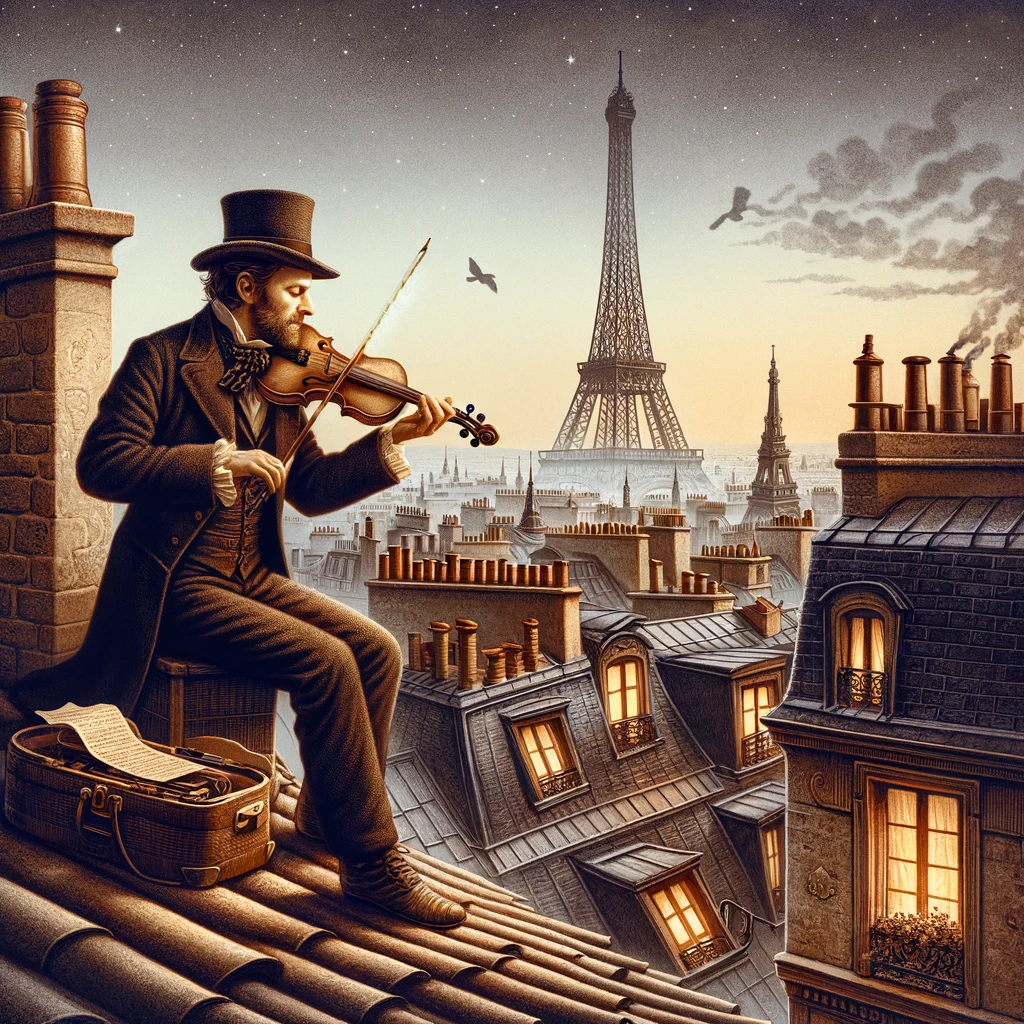
D-Day and Paul Verlaine’s “Chanson d’automne” and D-Day
The line “Les sanglots longs des violons de l’automne / Bercent mon coeur d’une langueur monotone” is from the poem “Chanson d’automne” (“Autumn Song“) by Paul Verlaine, a famous French poet. This poem is renowned for its evocative imagery and deep symbolism.
- “Les sanglots longs des violons de l’automne” (The long sobs of autumn’s violins): Here, Verlaine uses the metaphor of violins to represent the sounds and feelings of autumn. The “long sobs” suggest a sense of melancholy and longing. Autumn, a season often associated with decline and the end of the vitality of summer, is personified through the sound of violins, implying a mournful, reflective mood.
- “Bercent mon coeur d’une langueur monotone” (Soothe my heart with a monotonous languor): This line continues the melancholic mood. The word “bercent” (soothes or lulls) suggests a sense of being comforted or swayed gently, perhaps by the repetitive, somber rhythms of autumn. The “monotonous languor” evokes a feeling of weariness and a tinge of sadness, possibly reflecting the poet’s personal emotions or a general sense of existential melancholy.
The poem as a whole is often interpreted as an expression of the poet’s feelings of sadness, nostalgia, and a sense of passing time. The use of musical instruments as a metaphor for the seasons is a way to convey emotions and moods indirectly, creating a rich tapestry of symbolic meaning that resonates with the natural changes and emotional landscapes.
Interestingly, these lines gained historical significance during World War II. They were used as part of a coded message broadcast by the BBC to the French Resistance, signaling the imminent start of the D-Day invasion. In this context, the lines took on a new symbolic meaning of hope and liberation amidst a time of conflict and suffering.
The broadcasting of the BBC during World War II, particularly in relation to Paul Verlaine’s “Chanson d’automne”
The broadcasting of the BBC during World War II, particularly in relation to Paul Verlaine’s “Chanson d’automne,” had significant symbolic and practical impact.
- Context: During the Second World War, the BBC’s broadcasts were a vital source of information and a symbol of resistance against Nazi Germany. They provided news, instructions, and encouragement to occupied Europe. Radio was the primary medium for mass communication, reaching a wide audience across various nations under Axis control.
- Use of “Chanson d’automne“: The opening lines of Verlaine’s poem were used by the BBC as coded messages. The first three lines, “Les sanglots longs / des violons / de l’automne” (The long sobs of the violins of autumn), were a signal to the French Resistance that the D-Day invasion was imminent, to occur within the next two weeks. The subsequent lines, “Blessent mon coeur / d’une langueur / monotone” (Wound my heart with a monotonous languor), were broadcast to indicate that the invasion would begin within 48 hours.
- Symbolic Importance: The choice of Verlaine’s poem was symbolic. Its themes of melancholy and change resonated with the war-torn and oppressed populations of Europe. The use of a French poem was particularly poignant for the French Resistance, as it not only served a practical purpose but also was a nod to French culture and heritage, which were being suppressed under Nazi occupation.
- Impact and Reception: The broadcast had a profound impact. For the French Resistance, it was a call to action, mobilizing them for the critical role they would play in the D-Day operations. For the broader European audience, especially those in occupied territories, the message was a beacon of hope. It signaled that liberation was near, boosting morale and strengthening the resolve to resist.
- Legacy: This instance became one of the most famous examples of coded messages in wartime. It demonstrated the power of broadcasting, not just as a tool for communication, but as a weapon of psychological warfare and a symbol of resistance. The use of “Chanson d’automne” in this context added a layer of cultural significance to the poem, transforming it from a melancholic reflection on change to a symbol of hope and impending liberation.
The BBC’s broadcasts, especially this use of Verlaine’s poem, thus played a crucial role in the war effort, both in practical terms for the Resistance and in a broader symbolic sense for the European populace.
A visual illustration

The verse from Paul Verlaine’s “Chanson d’automne,” set on the Normandy coast of France. It portrays a scene of serene beauty and reflective solitude, aligned with the mood of the poem.
Appreciate the detail of the violin standing up in the illustration. It’s wonderful how such elements can add depth and character to an image, enhancing the thematic expression and emotional resonance of the poem.
Biography of Paul Verlaine in his own poetic style
Crafting a biography of Paul Verlaine in his own poetic style would involve blending lyrical expression with biographical facts, reflecting the melancholic and often turbulent nature of his life.
Here’s an attempt to capture his life story in a poetic manner:
In the dance of time, where shadows play and blend,
Lived a soul, whose words could gently bend.
Paul Verlaine, born in Metz’s embrace,
A poet whose life was both a caress and a chase.
In youth’s spring, his heart brimmed with song,
Verses flowing, tender, profound, and long.
Paris whispered secrets in his eager ear,
Promising a future both bright and clear.
Love’s whimsy led him to Mathilde’s side,
A union of hearts, a turbulent bride.
Yet, in his bosom, a storm did brew,
For another muse, Rimbaud, in skies of blue.
Their tempestuous bond, both fire and ice,
Fueled by passion, yet laden with vice.
A shot in the dark, a love turned sour,
Left Verlaine imprisoned in despair’s tower.
In the clink of chains, his spirit soared,
Penning verses, raw and adored.
“Sagesse,” “Fêtes galantes,” a lyrical spree,
Capturing life’s dance, its pain and glee.
Drink became his solace, his relentless foe,
Drowning sorrows in the lamplight’s glow.
Yet, through the fog, his verses shone,
A beacon of brilliance, uniquely his own.
As years waned, health did falter,
His poetic flame, no man could alter.
In the arms of solitude, Verlaine did lay,
Whispering to the world, in twilight’s ray.
A poet, a dreamer, lover, and sage,
Verlaine lived many a life upon life’s stage.
In every line, a piece of his heart,
A legacy in verse, an immortal art.
Thus, in the annals of time, his words reside,
A testament to love, pain, and pride.
Paul Verlaine, a soul both wild and tame,
Forever etched in the stars, an undying flame.

Paul Verlaine as a fiddler, playing a violin on a rooftop with Paris as the backdrop. This image captures the essence of Verlaine’s connection to the city and his role as a poetic ‘fiddler’, expressing the music of his soul against the historical setting of Paris.
Lets we forget! 📚🖌️🌟
